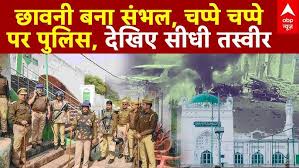On a recent day in Sambhal, Uttar Pradesh, an unfortunate incident of violence erupted at a mosque, leading to significant unrest in the area. This incident has sparked widespread concern and debate across the state and beyond. Reports suggest that clashes broke out following a dispute that escalated quickly, leaving several people injured and local authorities scrambling to restore order. The violence at the mosque is seen as part of a broader pattern of religious tensions in the region, exacerbated by political and social pressures.

Background: Understanding Sambhal’s Socio-Political Climate
Sambhal, a district located in the western part of Uttar Pradesh, has historically been a region where inter-community relations have been somewhat volatile. The area has witnessed various incidents of communal disharmony, and this recent violence is no exception. The district, like many parts of Uttar Pradesh, has a significant Muslim population, and tensions often flare up over issues related to religious identity, politics, and local governance.
The rise of hardline political movements and the increasing polarization in Uttar Pradesh have added fuel to the fire, making incidents like the Sambhal mosque violence more likely. The involvement of local religious leaders, coupled with the prevailing atmosphere of suspicion and mistrust, seems to have been a catalyst for the outbreak of violence.
The Violence: What Happened at the Mosque?
The violence at the mosque began following a disagreement between two groups that escalated rapidly. Early reports suggest that a religious procession or gathering was taking place when an altercation broke out, involving both locals and outside agitators. The situation quickly deteriorated as tensions escalated into stone-pelting, vandalism, and clashes between different groups.
As the violence intensified, police forces were deployed to restore order, but their presence seemed to do little to quell the anger and unrest. Several people were injured in the clashes, and there were reports of damage to the mosque, its property, and surrounding areas. The situation remained tense for several hours, with both sides blaming each other for provoking the violence.
The Role of Political Influence and Communal Tensions
The violence in Sambhal cannot be viewed in isolation from the political climate in Uttar Pradesh. The state has been a hotspot for communal tensions, and many analysts believe that political leaders are playing an active role in stoking these divisions. In the wake of the violence, local political figures quickly took to social media and public forums, each side attempting to shape the narrative in their favor.
In some cases, politicians and local leaders from both major political parties used the incident to rally their respective communities, further entrenching the division between them. The political exploitation of such incidents often exacerbates the violence, creating an environment where it becomes increasingly difficult for communities to live in harmony.
Impact on the Local Population
The violence at the mosque has had a profound impact on the local population. Not only were individuals physically hurt during the clashes, but the emotional and psychological toll on the community is likely to be lasting. Many families have been displaced temporarily due to the violence, while others remain in fear of further confrontations. Local businesses and infrastructure were also affected by the violence, with several areas experiencing curfews, shop closures, and travel restrictions.
Religious leaders have called for peace and calm, but there is a palpable sense of anxiety in the air. Many in the community feel that the situation is indicative of a larger, systemic problem that goes beyond this isolated incident.
Government Response and Law Enforcement Action
In response to the violence, the Uttar Pradesh government quickly deployed additional police forces to Sambhal. Curfews were imposed in the area to prevent further escalation, and authorities worked to monitor the situation closely. The police arrested several individuals in connection with the violence and began an investigation to determine the cause and identify those responsible for instigating the unrest.
Despite the swift actions taken by law enforcement, many critics argue that the state’s response was not robust enough in preventing the violence in the first place. Questions have been raised about the preparedness of the local authorities to handle such communal situations without letting them spiral out of control.
The Aftermath: Calls for Peace and Reconciliation
In the aftermath of the violence, there have been calls from various quarters for peace and reconciliation. Religious leaders, local community members, and even politicians have urged citizens to come together and rebuild trust. However, these calls for peace face significant challenges in a climate of suspicion and fear.
Efforts by community leaders to organize dialogues and peace meetings have been met with mixed reactions, as many people are hesitant to engage in discussions with those they perceive as responsible for the violence. The reconciliation process will likely take time, and much will depend on the actions of local and state authorities in addressing the root causes of the conflict.
Conclusion: The Need for Long-Term Solutions
The violence at the Sambhal mosque serves as a stark reminder of the deep-rooted communal tensions that continue to plague Uttar Pradesh and other parts of India. While temporary measures such as curfews and police interventions can help restore order in the short term, long-term solutions are needed to address the underlying issues of social polarization, religious intolerance, and political exploitation.












